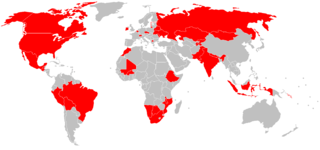
The Berber languages, also known as the Amazigh languages or Tamazight, are a branch of the Afroasiatic language family. They comprise a group of closely related but mostly mutually unintelligible languages spoken by Berber communities, who are indigenous to North Africa. The languages are primarily spoken and not typically written. Historically, they have been written with the ancient Libyco-Berber script, which now exists in the form of Tifinagh. Today, they may also be written in the Berber Latin alphabet or the Arabic script, with Latin being the most pervasive.

Libya, officially the State of Libya, is a country in the Maghreb region of North Africa. It is bordered by the Mediterranean Sea to the north, Egypt to the east, Sudan to the southeast, Chad to the south, Niger to the southwest, Algeria to the west, and Tunisia to the northwest. Libya comprises three historical regions: Tripolitania, Fezzan, and Cyrenaica. With an area of almost 1.8 million km2 (700,000 sq mi), it is the fourth-largest country in Africa and the Arab world, and the 16th-largest in the world. The country's official religion is Islam, with 96.6% of the Libyan population being Sunni Muslims. The official language of Libya is Arabic, with vernacular Libyan Arabic being spoken most widely. The majority of Libya's population is Arab. The largest city and capital, Tripoli, is located in north-western Libya and contains over a million of Libya's seven million people.

Demographics of Libya is the demography of Libya, specifically covering population density, ethnicity, education level, health of the populace, economic status, and religious affiliations, as well as other aspects of the Libyan population. The Libyan population resides in the country of Libya, a territory located on the Mediterranean coast of North Africa, to the west of and adjacent to Egypt. Libyans live in Tripoli. It is the capital of the country and first in terms of urban population, as well as Benghazi, Libya's second largest city.

Of the languages of France, French is the sole official language according to the second article of the French Constitution. French, a Gallo-Romance language, is spoken by nearly the entire population of France.

Fezzan is the southwestern region of modern Libya. It is largely desert, but broken by mountains, uplands, and dry river valleys (wadis) in the north, where oases enable ancient towns and villages to survive deep in the otherwise inhospitable Sahara Desert. The term originally applied to the land beyond the coastal strip of Africa proconsularis, including the Nafusa and extending west of modern Libya over Ouargla and Illizi. As these Berber areas came to be associated with the regions of Tripoli, Cirta or Algiers, the name was increasingly applied to the arid areas south of Tripolitania.
Awjila is a severely endangered Eastern Berber language spoken in Cyrenaica, Libya, in the Awjila oasis. Due to the political situation in Libya, immediate data on the language has been inaccessible. However, Facebook postings by speakers and younger semi-speakers have provided some recent supplementary data.

Arabization or Arabisation is the process of growing Arab influence on non-Arab populations, causing a language shift by the latter's gradual adoption of the Arabic language and assimilation into Arab culture or the fusion of local cultures with it. Arabization took place after the Muslim conquest of the Middle East and North Africa, as well as during the Arab nationalist policies of some governments in modern Arab states toward non-Arab minorities, including Algeria, Iraq, Kuwait, and Sudan.
The Northern Berber languages are a dialect continuum spoken across the Maghreb, constituting a subgroup of the Berber branch of the Afroasiatic family. Their continuity has been broken by the spread of Arabic, and to a lesser extent by the Zenati group of Northern Berber. The Zenati idioms share certain innovations not found in the surrounding languages; notably a softening of k to sh and an absence of a- in certain words, such as "hand"
The Zenati languages are a branch of the Northern Berber language family of North Africa. They were named after the medieval Zenata Berber tribal confederation. They were first proposed in the works of French linguist Edmond Destaing (1915) (1920–23). Zenata dialects are distributed across the central Berber world (Maghreb), from northeastern Morocco to just west of Algiers, and the northern Sahara, from southwestern Algeria around Bechar to Zuwara in Libya. The most widely spoken Zenati languages are Tmazight of the Rif in northern Morocco and Tashawit Berber in northeastern Algeria, each of which have over 3 million speakers.

Ghadames or Ghadamis is an oasis Berber town in the Nalut District of the Tripolitania region in northwestern Libya.
Libyan Arabic, also called Sulaimitian Arabic by scholars, is a variety of Arabic spoken in Libya, and neighboring countries. It can be divided into two major dialect areas; the eastern centred in Benghazi and Bayda, and the western centred in Tripoli and Misrata. The Eastern variety extends beyond the borders to the east and share the same dialect with far Western Egypt, Western Egyptian Bedawi Arabic, with between 90,000 and 402,000 speakers in Egypt. A distinctive southern variety, centered on Sabha, also exists and is more akin to the western variety. Another Southern dialect is also shared along the borders with Niger with 12,000 speakers in Niger as of 2019.

Egyptians speak a continuum of dialects. The predominant dialect in Egypt is Egyptian Colloquial Arabic or Masri/Masry, which is the vernacular language. Literary Arabic is the official language and the most widely written. The Coptic language is used primarily by Egyptian Copts and it is the liturgical language of Coptic Christianity.

Domari is an endangered Indo-Aryan language, spoken by Dom people scattered across the Middle East and North Africa. The language is reported to be spoken as far north as Azerbaijan and as far south as central Sudan, in Turkey, Iran, Iraq, Palestine, Jordan, Egypt, Sudan, Libya, Tunisia, Algeria, Morocco, Syria and Lebanon. Based on the systematicity of sound changes, it is known with a fair degree of certainty that the names Domari and Romani derive from the Indo-Aryan word ḍom. Although they are both Central Indo-Aryan languages, Domari and Romani do not derive from the same immediate ancestor. The Arabs referred to them as Nawar as they were a nomadic people that originally immigrated to the Middle East from the Indian subcontinent.
The people of the Maghreb and the Sahara speak various dialects of Berber and Arabic and almost exclusively follow Islam. The Arabic and Berber groups of languages are distantly related, both being members of the Afro-Asiatic family. The Sahara dialects are notably more conservative than those of coastal cities. Over the years, Berber peoples have been influenced by other cultures with which they came in contact: Nubians, Greeks, Phoenicians, Egyptians, Romans, Vandals, Arabs, and lately Europeans. The cultures of the Maghreb and the Sahara therefore combine indigenous Berber, Arab and elements from neighboring parts of Africa and beyond. In the Sahara, the distinction between sedentary oasis inhabitants and nomadic Bedouin and Tuareg is particularly marked.
Ghadamès is a Berber language that is spoken in, and named after, the oasis town of Ghadames in Nalut District, western Libya.

The Arab world consists of 22 states. As of 2021, the combined population of all the Arab states was around 475 million people.

The languages of Mauritania mainly consist of various Afroasiatic languages, including: Zenaga-Berber, Tamasheq-Berber, Hassaaniya Arabic and Standard written Arabic. French is also used due to colonial influence. Some ethnic minorities speak Niger-Congo languages.

Matmata Berber is a Zenati Berber dialect spoken around the town of Matmâta in southern Tunisia, and in the villages of Taoujjout, Tamezret and Zrawa. According to Ben Mamou's lexicon, its speakers call it Tmaziɣṯ or Eddwi nna, meaning "our speech", while it is called Shelha or Jbali (جبالي) in local Tunisian Arabic dialects. The total population speaking this variety was estimated at 3,726 in 1975.
The varieties of Arabic, a Semitic language within the Afroasiatic family originating in the Arabian Peninsula, are the linguistic systems that Arabic speakers speak natively. There are considerable variations from region to region, with degrees of mutual intelligibility that are often related to geographical distance and some that are mutually unintelligible. Many aspects of the variability attested to in these modern variants can be found in the ancient Arabic dialects in the peninsula. Likewise, many of the features that characterize the various modern variants can be attributed to the original settler dialects as well as local native languages and dialects. Some organizations, such as SIL International, consider these approximately 30 different varieties to be separate languages, while others, such as the Library of Congress, consider them all to be dialects of Arabic.

Many countries and national censuses currently enumerate or have previously enumerated their populations by languages, native language, home language, level of knowing language or a combination of these characteristics.















